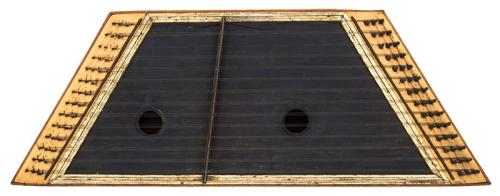Home
>
Works
>
Hammered dulcimer
>
Advanced Search
Folk, Indigenous, and Global
Zithers and Dulcimers

Hammered dulcimer

Hammered dulcimer
Alternate name:Zither
Date: 1885-1910 ca.
Place Made:England, Europe
Place Made:United States, North America
Model: none
Serial No: none
Signednone
Markingsnone
DescriptionTrapezoidal wooden case with outwardly angled pin blocks, sides of case stained/varnished with light-colored (maple/pine) pin blocks; 14 triple-strung courses and no bass courses nor a second/bass bridge (individual or otherwise); single, one-piece treble bridge with iron rod set into groove – internal support for bridge is a single sound post, located more or less between sound holes; iron rod nut at each pin block; two circular sound holes, wooden trim/insert but no rosette; soundboard painted black with gold-painted decorative trim; 42 hitch pins and 42 Square-headed tuning pins
Wooden case with leather strap closures, marked on case: Geo Smith, 1310 26 Av NE, Minneapolis, Minnesota, U.S.A.Label on case: White Star Line, Second Class, Mr. & Mrs. George Smith, Passenger to Montreal via Liverpool, Per R. M. S. Megantic, sailing Jul
The configuration of this instrument has been altered to accommodate triple-strung treble strings only. Wear marks on the soundboard suggest a second bridge was part of a former set-up; however, the extant bridge would not allow for bass courses to pass unobstructed between tuning and hitch pins.
There are markings on both pin blocks that indicate 8 double-strung bass courses may have been planned for the reconfiguration.
This instrument has features common to those made in English and American traditions, including trapezoidal shape, thick backboard (supporting much of the string tension), and pin blocks joined directly to the backboard and sides. The configuration of triple-stringing throughout what would have been treble and bass ranges may indicate an stronger argument for English attribution.
Based on information about the ship’s use, passage from Montreal to Liverpool took place between 1908-1915, and later 1919-1928. She was used during WWI to transport troops. From 1928-1931, her course was routed from London and Southampton, no longer Liverpool.
Wooden case with leather strap closures, marked on case: Geo Smith, 1310 26 Av NE, Minneapolis, Minnesota, U.S.A.Label on case: White Star Line, Second Class, Mr. & Mrs. George Smith, Passenger to Montreal via Liverpool, Per R. M. S. Megantic, sailing Jul
The configuration of this instrument has been altered to accommodate triple-strung treble strings only. Wear marks on the soundboard suggest a second bridge was part of a former set-up; however, the extant bridge would not allow for bass courses to pass unobstructed between tuning and hitch pins.
There are markings on both pin blocks that indicate 8 double-strung bass courses may have been planned for the reconfiguration.
This instrument has features common to those made in English and American traditions, including trapezoidal shape, thick backboard (supporting much of the string tension), and pin blocks joined directly to the backboard and sides. The configuration of triple-stringing throughout what would have been treble and bass ranges may indicate an stronger argument for English attribution.
Based on information about the ship’s use, passage from Montreal to Liverpool took place between 1908-1915, and later 1919-1928. She was used during WWI to transport troops. From 1928-1931, her course was routed from London and Southampton, no longer Liverpool.
DimensionsBottom: 36-3/8 in (923 mm)
Top: 20-5/8 in (523 mm)
Angled sides: 15-1/2 in (393 mm)
Depth: 2-5/8 in (66 mm)
Top: 20-5/8 in (523 mm)
Angled sides: 15-1/2 in (393 mm)
Depth: 2-5/8 in (66 mm)
ProvenanceArne B. Larson Collection, Vermillion, South Dakota, 1979.
Terms
Credit Line: Arne B. Larson Collection, 1979
Not on view
Object number: 01240
